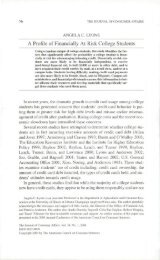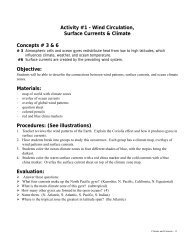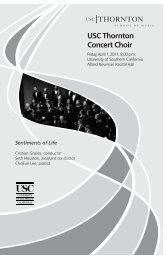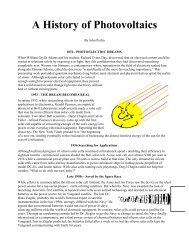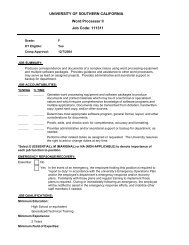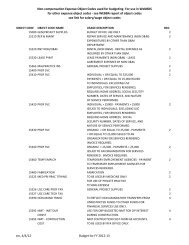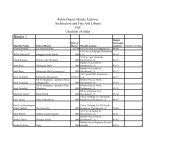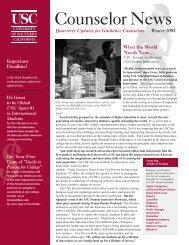Multiple-Unit Artificial Retina Chipset System To Benefit The Visually ...
Multiple-Unit Artificial Retina Chipset System To Benefit The Visually ...
Multiple-Unit Artificial Retina Chipset System To Benefit The Visually ...
You also want an ePaper? Increase the reach of your titles
YUMPU automatically turns print PDFs into web optimized ePapers that Google loves.
<strong>Multiple</strong>-<strong>Unit</strong> <strong>Artificial</strong> <strong>Retina</strong> <strong>Chipset</strong> <strong>System</strong><br />
<strong>To</strong> <strong>Benefit</strong> <strong>The</strong> <strong>Visually</strong> Impaired<br />
Wentai Liu, Elliot McGucken, Mark Clements, Chris DeMarco, Kasin<br />
Vichienchom, Chris Hughes. Department of Electrical and Computer<br />
Engineering, North Carolina State University, Raleigh, NC 27695-7814<br />
Mark Humayun, James Weiland, Robert Greenberg (Mann Foundation),<br />
Eugene de Juan, <strong>The</strong> Wilmer Eye Institute, Johns Hopkins University,<br />
Baltimore, MD 21287-9277<br />
ABSTRACT<br />
A multiple-unit artificial retina chipset (MARC) system to benefit the visually<br />
impaired is presented. <strong>The</strong> rehabilitative device replaces the functionality of defective<br />
photoreceptors within patients suffering from <strong>Retina</strong>l Pigmentosa (RP) and Age-<br />
Related Macular Degeneration (AMD). <strong>The</strong> components of the MARC system are<br />
characterized, from the extraocular video camera, video processing chip, and RF<br />
generator and primary coil, to the intraocular secondary coil, rectifier and regulator,<br />
MARC processing and demultiplexing chips, and the electrode array. <strong>The</strong> fabrication<br />
and testing of the first three generation MARC VLSI chips are summarized. <strong>The</strong> novel<br />
RF data protocol transfer via RF is outlined, and the chip’s decoding circuitry is<br />
characterized. A synthesis of the engineering, biological, medical, and physical<br />
research is offered within the presentation of methods and means for the overall design<br />
engineering, powering, bonding, packaging, and hermetic sealing of the double-sided<br />
MARC retinal prosthesis. <strong>The</strong> biological and clinical studies pertaining to retinal<br />
neural stimulation are discussed, along with their implications for electrode design.<br />
1. Introduction<br />
<strong>The</strong> multiple-unit artificial retina chipset (MARC) is designed to provide useful<br />
vision to over 10,000,000 people blind because of photoreceptor loss due to partial<br />
retinal degeneration from diseases such as Age Related Macular Degeneration (AMD)<br />
and Retinitis Pigmentosa (RP). <strong>The</strong> retinal prosthesis is based on the fundamental<br />
concept of replacing photoreceptor function with an electronic device, which was<br />
initiated by and has been developed by Dr. Humayun et al.[1,2,3] A discrete percept<br />
was elicited in fourteen out of fifteen patients tested, thirteen with their vision impaired<br />
by RP, and two with end-stage AMD. <strong>The</strong> patients were able to identify the stimulated<br />
retinal quadrant by the change in position of the visual sensation. This in addition to<br />
the demonstration that simultaneous electrical stimulation less than 300μm apart<br />
resulted in two distinct percepts suggested that multi-focal electrical stimulation of the
etina might be a viable approach to providing visual input to patients who have<br />
profound visual loss due to outer retinal degenerations. A stimulating current of 600<br />
μA passed through an electrode 400 μm in diameter elicited a visual percept[3].<br />
Humayun et al. were able to demonstrate that a 2x2 mm 2 5x5 silicone rubber and<br />
platinum or iridium[4,5] electrode array could be used to stimulate simple images upon<br />
the patient’s retina[14]. Pattern electrical stimulation of the retina was tested in 2<br />
patients. <strong>The</strong> first patient was able to perceive an activated ‘U’-shaped electrode<br />
pattern as an ‘H’. <strong>The</strong> second patient correctly identified a square electrode pattern as a<br />
‘match box.’ Building upon these medical results, our team[6,7,8] of medical doctors,<br />
physicists, and engineers have worked towards developing MARC prototypes based<br />
upon the clinical stimulation data[3] outlined in Figure 1. For retinal stimulation in<br />
blind patients it was determined that the biphasic current pulse amplitude A should be<br />
100-600 μA, the current pulse duration B should be 0.1ms-2ms, and the period between<br />
biphasic pulses C should be 8ms –100 ms, corresponding to a stimulating frequency of<br />
10 Hz – 125 Hz.<br />
μA<br />
t<br />
A<br />
B<br />
C<br />
Figure 1: Bipolar current pulse waveform parameters for retinal stimulation.<br />
<strong>The</strong> photoreceptors in a healthy retina, which manifest themselves as rods and<br />
cones, initiate a neural signal in response to light. This neural signal is then processed<br />
by the bipolar cells and ganglion cells before being sent along the surface of the retina<br />
towards the optic nerve, which resides towards the center of the retina. Photoreceptors<br />
are almost completely absent in the retina of end-stage RP and AMD patients, while the<br />
bipolar cells and ganglion cells, through which the photoreceptors normally synapse,<br />
survive at high rates. <strong>The</strong> ganglion and bipolar cells remain intact, and due to the<br />
anatomy of the retina, they are in a position where they may respond to electrical<br />
stimulation. Silicon photonic devices can be fabricated to respond to the visible<br />
spectrum, and electrodes can be designed to stimulate nerve cells. Thus the basic task<br />
2
in creating a retinal prosthesis is to engineer an artificial intermediary device which<br />
resides in-between the silicon photonic device which can transduce an image of a visual<br />
scene and the operative neurons which the electrodes interface with and stimulate.<br />
Figure 2A: <strong>The</strong> MARC <strong>System</strong><br />
3
In our case, the intermediary device is the MARC system pictured in Figures 2A and<br />
2B. <strong>The</strong> schematic of the components of the MARC to be implanted consists of a<br />
secondary receiving coil mounted in close proximity to the cornea, a power and signal<br />
transceiver and processing chip, a stimulation-current driver, and a proposed electrode<br />
array fabricated on a material such as silicone rubber[3,14], thin silicon[9], or<br />
polyimide[25] with ribbon cables connecting the devices. <strong>The</strong> biocompatibility of<br />
polyimide[10,11] is being studied, and its thin, lightweight consistency suggests its<br />
possible use as a non-intrusive material for an electrode array. Titanium tacks[12] or<br />
cyanoacrylate glue[13] may be used to hold the electrode array in place.<br />
Figure 2B: RF coil configuration of MARC system.<br />
Secondary coil may also be implanted intraocularly.<br />
<strong>The</strong> stimulating electrode array, an example of which is given in Figure 3, is<br />
mounted on the retina while the power and signal transceiver is mounted in close<br />
proximity to the cornea. An external miniature low-power CMOS camera worn in an<br />
0.6 mm<br />
5.4 mm<br />
0.6 mm<br />
5.4 mm<br />
0.4 mm<br />
Figure 3: A 5x5 platinum electrode array for retinal stimulation fabricated on<br />
silicone rubber and used by doctors at JHU, along with electrode dimensions for a a<br />
similar 10x10 array.<br />
4
eyeglass frame will capture an image and transfer the visual information and power to<br />
the intraocular components via RF telemetry. <strong>The</strong> intraocular prosthesis will decode the<br />
signal and electrically stimulate the retinal neurons through the electrodes in a manner<br />
that corresponds to the image acquired by the CMOS Camera.<br />
Figure 4: Photograph of MARC3 Chip<br />
Due to the size of the intraocular cavity, the delicate tissue-paper like thickness<br />
of the retina (100-300 μm), and the fact that the eye is mobile, a retinal implant poses<br />
difficult engineering challenges. Over the past several years all of these factors and<br />
constraints have been taken into consideration in the engineering research of our<br />
implantable double-sided MARC device. Encouraging results from clinical tests and<br />
engineering have inspired these efforts to produce a prototype human retinal implant.<br />
<strong>The</strong>se results include: 1) Tests in blind volunteers have demonstrated that controlled-<br />
pattern electrical stimulation of the remaining retinal neurons using hand-held electrode<br />
arrays wired to a PC-controlled signal generator results in vision compatible with<br />
mobility and recognizing large-letter forms[3,14,15]. 2) Preliminary bio-compatibility<br />
tests in animals performed by researchers at Johns Hopkins University have shown that<br />
the eye can tolerate the proposed materials as well as the surgical implantation[16]. 3)<br />
Technology exists for the transmission of power and data using RF telemetry[17]. 4)<br />
Standard semiconductor technology can be used to fabricate a power and signal<br />
receiving chip, which would then drive current through an electrode array and stimulate<br />
5
the retinal neurons[4,5]. 5) <strong>The</strong> first three generations of MARC chips have been<br />
designed, fabricated, and tested at North Carolina State University.<br />
2. Feasibility and Significance of the MARC<br />
Before embarking on the chip design, it was necessary to assess how useful an<br />
image of limited spatial resolution would be to blind individuals. A 1024 pixel image<br />
(32x32 array of electrodes) subtending a visual angle of 1.7 0 , or a 0.5 mm area of the<br />
central retina, would allow good visual acuity (20/26) with a constricted visual<br />
field[3,18]. A coarser 25x25 array would enable mobility in environments not<br />
requiring a high degree of pattern recognition[3,19]. Simple visual feasibility<br />
experiments have been conducted at NCSU so as to determine how well sight could be<br />
restored with a 15x15 array of pixels, each of which would be capable of four-bit<br />
stimulation, or sixteen gray levels. A picture from a video camera was projected onto a<br />
television screen at the low resolution of 15x15 pixels. When subjects who wore<br />
glasses removed their glasses, or when those with good sight intentionally blurred their<br />
vision, the natural spatial-temporal processing of the brain allowed them to actually<br />
distinguish features and recognize people. When the subject focused on the screen, it<br />
appeared as a 15x15 array of gray blocks, but when the subject "trained" themselves to<br />
unfocus their vision, they were able to "learn" to see definitive edges and details such as<br />
beards, teeth, and opened or closed eyes. <strong>The</strong>se results are reminiscent of the<br />
experiences with the artificial cochlear implant. When the artificial cochlear was<br />
originally being designed, it was believed that over 2,400 electrodes would be needed<br />
to stimulate the nerves in a manner that would be conducive to hearing. <strong>To</strong>day,<br />
however, within a few weeks of receiving an implant, a patient can understand phone<br />
conversations with an artificial cochlear manufactured by Advanced Bionics that has<br />
only six electrodes. One of the advantages of this project is that the MARC device will<br />
be interfaced with the world's greatest computer -- the brain. <strong>The</strong> MARC won't be<br />
duplicating the exact functioning of the retina, but rather the device will be an entity<br />
that the brain will “learn” to use. Thus we believe that a 15x15 pixel array will<br />
facilitate a level of sight which will be of significant value to the patient.<br />
6
3. Overall <strong>System</strong> Functionality<br />
<strong>The</strong> MARC system, pictured in Figures 1-4 will operate in the following<br />
manner. An external camera will acquire an image, whereupon it will be encoded into<br />
data stream which will be transmitted via RF telemetry to an intraocular transceiver. A<br />
data signal will be transmitted by modulating the amplitude of a higher frequency<br />
carrier signal. <strong>The</strong> signal will be rectified and filtered, and the MARC will be capable<br />
of extracting power, data, and a clock signal. <strong>The</strong> subsequently derived image will then<br />
be stimulated upon the patient’s retina.<br />
Video<br />
Camera<br />
Image<br />
Processor<br />
PWM<br />
Encoder<br />
Outside<br />
Eye<br />
MARC SYSTEM BLOCK DIAGRAM<br />
DIAGRAM<br />
Class-E<br />
Power<br />
Amplifier<br />
ASK<br />
Modulator<br />
MARC<br />
Diagnostics<br />
RF Telemetry Coils<br />
Inside<br />
Eye<br />
Figure 5: MARC <strong>System</strong> Functionality<br />
As shown in Figures 1-5, the MARC system would consist of two parts which<br />
separately reside exterior and interior to the eyeball. Each part is equipped with both a<br />
transmitter and a receiver. <strong>The</strong> primary coil can be driven with a 0.5-10 MHz carrier<br />
signal, accompanied by a 10 kHz amplitude modulated (AM/ASK) signal which<br />
provides data for setting the configuration of the stimulating electrodes. A DC power<br />
supply is obtained by the rectification of the incoming RF signal. <strong>The</strong> receiver on the<br />
secondary side extracts four bits of data for each pixel from the incoming RF signal and<br />
provides filtering, demodulation, and amplification. <strong>The</strong> extracted data is interpreted by<br />
the electrode signal driver which finally generates appropriate currents for the<br />
stimulating electrodes in terms of magnitude, pulse width, and frequency.<br />
7<br />
Power<br />
Recovery<br />
Electrode<br />
Status<br />
Electrode<br />
Stimulator 1<br />
ASK<br />
Demodulator<br />
Configuration<br />
& Control<br />
Electrode<br />
Stimulator N<br />
Clock & Data<br />
Recovery<br />
Electrode<br />
Stimulator 20
4. Advantages of the MARC <strong>System</strong><br />
Several limitations of previous approaches[20,21,22,23,24,25,25] to visual<br />
prostheses are overcome by the designs of the MARC1-4 systems:<br />
i) Component Size: <strong>The</strong> novel multiple-unit intraocular transceiver processing and<br />
electrode array-processing visual prosthesis allows for larger processing chips (6x6<br />
mm), and thus more complex circuitry. Also, by splitting the chips up into smaller<br />
components, and utilizing techniques such as solder bumping to connect the chips with<br />
flexible electrode substrates, we shall keep the sizes to a minimum.<br />
ii) Heat Dissipation: <strong>The</strong> power transfer and rectification in the MARC-2 and<br />
MARC-3 designs are primary sources of heat generation, and they occur near the<br />
corneal surface, or at least remotely from the retina, rather than in close proximity to<br />
the more delicate retina.<br />
iii) Powering: <strong>The</strong> multiple-unit intraocular transceiver-processing and electrode array-<br />
processing visual prosthesis provides a more direct means for power and signal transfer,<br />
as the transceiver processing unit is placed in close proximity to the cornea, making it<br />
more accessible to electromagnetic radiation in either the visible wavelength range or<br />
radio waves. Solar powering and especially RF powering are made more feasible.<br />
iv) Diagnostic Capability: <strong>The</strong> transceiver unit is positioned close to the cornea, and<br />
thus it can send and receive radio waves, granting it the capability of being<br />
programmed to perform different functions as well as giving diagnostic feedback to an<br />
external control system. Diagnostic feedback would be much more difficult with the<br />
solar powering.<br />
v) Physiological Functionality: <strong>The</strong> MARC was designed in conformance with the<br />
physiological data gained during tests on blind patients. We are the only group who has<br />
yet created a visual percept (with electrical stimulation) in a patient. <strong>The</strong>refore, we have<br />
the unique advantage of designing around parameters which are guaranteed to work.<br />
vi) Reduction of Stress Upon <strong>The</strong> <strong>Retina</strong>: Our device would reduce the stress upon<br />
the retina, as it would only necessitate the mounting of the electrode array upon the<br />
delicate surface, while the signal processing and power transfer could be performed off<br />
the retina. Also, buoyancy could be added to the electrode array, to give it the same<br />
average density as the surrounding fluid.<br />
8
5. Technical Specifications of the MARC1-3 Chips<br />
A NSF grant allowed for exploration of the engineering aspects of the retinal<br />
prosthesis project, which was centered about the MARC processing chips. <strong>The</strong> chips<br />
are all designed in accordance with the biological constraints determined by our<br />
group[26], as well as the technological constraints imposed by the standard AMI 2μm<br />
and 1.2μm CMOS design processes. Calculations concerning the requisite power for<br />
the dual-unit retina chip are as follows: Dr. Humayun et al.'s experiments have shown<br />
that a 600 μA with 2 ms bipolar pulse is required for initial retinal stimulation. <strong>The</strong><br />
equivalent retinal impedance seen by the electrode is 10Kohms. <strong>To</strong> prevent flicker<br />
perception, there must be present at least a 60 Hz image presentation rate which means<br />
that the 600 μA must be generated 60 times a second per driver, or once every 16.6 ms.<br />
In recent tests the 600 μA stimulation seemed to be saturating the retina. It was<br />
also found that an array of positive (anodic) microsecond pulses followed by an array<br />
of negative (cathodic) microsecond pulses would give better results, allowing for a<br />
stimulation with 100 μA, implying that lower currents will be enough to stimulate the<br />
retina.<br />
5A. MARC1<br />
MARC1[4,5] consists of a photosensing, processing, and stimulating chip<br />
fabricated in 2.0 μm CMOS, which is endowed with a 5x5 phototransistor array.<br />
Measuring 2x2 mm 2 in dimension, it has been used to demonstrate that current<br />
stimulation patterns corresponding to simple images, such as the letter "E" presented<br />
optically to the chip, can be generated and used to drive the 5x5 array of electrodes.<br />
<strong>The</strong> chip delivered the requisite power for stimulation, as was determined by our<br />
clinical studies conducted on visually-impaired patients with RP and AMD. For each<br />
of the 25 individual photosensing pixels, we were able to adjust VDD, the clock<br />
frequency, the sensitivity to light, and the current output. <strong>The</strong> chip is fully packaged in<br />
a standard 40 pin DIP package, facilitating interconnect via a ribbon cable from the<br />
chip to the stimulating electrode array.<br />
9
Photodetecting Circuit Current Pulse Generator<br />
Figure 6: MARC1 Photodetecting and stimulating circuit.<br />
Each pixel on the MARC1 is divided into two parts, the photoreceptor and the<br />
current pulse generator, as shown in Figure 6. <strong>The</strong> photoreceptor converts light<br />
intensity into a voltage level. This voltage level is then compared to the threshold<br />
voltage Vth in the comparator, which controls the current pulse driver circuit. If light<br />
intensity is stronger than the threshold value, a biphasic stimulating signal is generated<br />
by that pixel. Timing of the current pulse is controlled by external pulses and a clock<br />
signal. <strong>The</strong> chip has been designed with the biological stimulating constraints<br />
determined in clinical studies conducted on patients with RP and AMD. It successfully<br />
delivered the 600 μA current in 1 millisecond bipolar pulses, which were required for<br />
retinal stimulation. Test results are shown in Figure 7.<br />
10
Figure 7: Waveform from MARC1 Testing: <strong>The</strong> output from the “on” pixels,<br />
which resulted in 250 μA, 2ms pulses at a 50 Hz clock rate, are shown, beneath<br />
the external clock signal.<br />
By successfully fabricating and testing a chip which receives an image and<br />
delivers the requisite currents for human retinal stimulation to a 5x5 electrode array, we<br />
gained the necessary insight and expertise which is allowing us to design the second<br />
and third generation chips which will drive 10x10 and 25x25 photosensing arrays. <strong>The</strong><br />
design of MARC1 includes enhanced holed CMOS phototransistors[6]. This chip was<br />
designed before it was suggested that we split the components into two pieces, so as to<br />
facilitate the transmission of energy into the eye. As RF powering became feasible, so<br />
did telemetry and the transmission of visual information from an exterior camera. Thus<br />
it was decided that all the video would be processed exterior to the eye.<br />
5B. MARC3 Technical Specifications<br />
MARC3 [5,6,27], shown in Figures 4 and 5, is capable of driving a 10x10<br />
electrode array, which was determined to be the minimum acceptable size to make the<br />
11
surgical implantation within a patient worthwhile. <strong>The</strong> MARC3 was designed to<br />
demonstrate the wireless power and data transfer for the retinal prosthesis, and it was<br />
also designed to provide a flexible waveform generator, as the optimum stimulating<br />
parameters have yet to be determined, as depicted in Figure 1.<br />
<strong>The</strong> basic architecture of MARC3 is depicted in Figure 9 [7]. MARC3 is<br />
endowed with 20 controlled, variable current sources designed for retinal stimulation,<br />
each of which is connected to five electrodes through a demultiplexer. Each current<br />
source provides a four bit (sixteen level) linear “greyscale” stimulus. Binary amplitude<br />
shift keying (ASK), shown in Figure 8, is used as the modulation scheme. <strong>The</strong> RF<br />
carrier is ASK modulated according to a pulse-width modulated digital waveform that<br />
encodes both clock and serial data signals. <strong>The</strong> ASK demodulator recovers the digital<br />
pulse width modulation (PWM) waveform from the envelope of the inductively<br />
coupled ASK power and data waveform. <strong>The</strong> inductive link RF telemetry power<br />
recovery circuits support a carrier frequency in the range of 1 to 10 MHz. ASK and<br />
PWM are the standard mechanism for data transfer in existing RF Telemetry<br />
devices[28,29].<br />
After the chip first receives the RF signal in the power-up stage, the data is sent<br />
in two distinct segments. First, a block of configuration data is delivered which sets the<br />
pulse width, height and period variables depicted in Figure 1. <strong>The</strong>n, actual image data<br />
is transmitted.<br />
<strong>The</strong> clock is simply defined by the rising edge of the pulses, so no explicit clock<br />
recovery circuits beyond the ASK-demodulator and a delay locked loop (for PWM<br />
demodulation) are required. <strong>The</strong> clock and data recovery circuits support serial data<br />
rates ranging from 20 KHz to 1 MHz. ASK allows for simple, non-coherent detection<br />
by a comparator with hysteresis, meaning that a high signal going low must cross a<br />
lower threshold than a low signal going high in order to register the change. This was<br />
implemented as a safeguard against noise which may arise due to random fluctuations<br />
and relative movement of the RF telemetry coils. <strong>The</strong> ASK modulation is driven by a<br />
pulse-width modulated digital waveform that encodes both clock and serial data<br />
signals. <strong>The</strong> ASK demodulator in the stimulus device recovers this PWM waveform,<br />
12
and it stimulates the appropriate electrodes, in a manner that corresponds to the external<br />
image.<br />
Future external circuits which process diagnostic feedback from the circuit may<br />
be equipped with FM capability, while the intraocular circuitry shall possess the less-<br />
engineering-intensive AM capability.<br />
Figure 8. Amplitude shift keyed pulse-width modulation transmission<br />
of data, with alternate mark inversion encoding scheme.<br />
<strong>The</strong> data bits are encoded in the following manner: the positions of falling edges<br />
of the PWM waveform are examined with respect to the previous rising edge, as shown<br />
in Figure 8. <strong>The</strong> width or duty cycle of the pulses carries the information. Each pulse<br />
encodes one bit of data using an alternate mark inversion scheme, where zeros are<br />
represented by 50 percent duty cycle pulses and ones by pulses with alternating larger<br />
or smaller duty cycles (75% and 25%, respectively) symmetric around 50 percent. A<br />
simple delay-locked loop circuit can recover the data bits from the PWM waveform.<br />
<strong>The</strong> stimulus device has external diagnostic interfaces that allow the observation<br />
of the demodulated PWM waveform, the recovered clock and data signals, and the<br />
synchronization signal. <strong>The</strong> chips are also equipped to have each of these signals<br />
driven externally. <strong>The</strong>se interfaces allow individual testing of the major components of<br />
the device in either an artificial or biological environment.<br />
<strong>The</strong> RF carrier envelope is obtained by rectifying and filtering the output of the<br />
receiving coil. <strong>The</strong> low-pass filter bandwidth is chosen to suppress the carrier while<br />
passing the PWM modulating signal. <strong>The</strong> image data is recovered from the PWM<br />
waveform by a simple recovery circuit based on a delay-locked loop.<br />
13
ASK<br />
ASK Demodulator<br />
PWM<br />
CLOCK AND DATA<br />
Recovery<br />
Figure 9: MARC3 Architecture<br />
<strong>The</strong> prosthesis chip has twenty current pulse stimulator circuits, each of which<br />
implements 4-bit linear control of the current pulse amplitude. <strong>The</strong> drivers operate in<br />
one of three current ranges, with full-scale currents of 200, 400, and 600 uA. <strong>The</strong> LSB<br />
current increments for these ranges are 12.5, 25, and 37.5 uA, respectively. A single<br />
full-scale current for all twenty drivers is selected during configuration.<br />
(DLL)<br />
Timing Generator<br />
Electrode Stimulator Electrode Stimulator<br />
<strong>The</strong> most straightforward way to create the bipolar current pulses required to<br />
stimulate the retinal neurons would require dual power supply rails with a voltage span<br />
greater than 12V, as well as positive and negative current sources. This high voltage<br />
14<br />
External Interface<br />
Clock<br />
Data<br />
Synchronization<br />
Current Control<br />
R/C<br />
Electrode Stimulator<br />
1 2 20<br />
Electrodes
4-bit DAC<br />
exceeds the breakdown voltage of the oxide layer in >2μm CMOS technology. <strong>To</strong><br />
avoid these difficulties, a switched bridge circuit was designed[7] so as to allow the<br />
generation of bipolar pulses with a single current source. <strong>The</strong> bridge is shown<br />
conceptually in Figure 10, along with the demultiplexer.<br />
S1<br />
S1 - S4<br />
S5 - S9<br />
S3 S4<br />
Figure 10: Bridge switches (S1-S4) for biphasic pulse generation, demultiplexer<br />
switches (S5-S9) to select electrode A-E, and neutralizing switches (N1-N5) to “zero<br />
out” electrodes. Resistances in schematic represent the load of the retinal neurons.<br />
6. Extraocular CMOS Camera & Video Processing<br />
N1<br />
Switch to Generate Bi-phase Current Pulses<br />
S2<br />
Demultiplex to Five Electrodes A - E<br />
N1 - N5 : Neutralizing Switches<br />
S5<br />
Standard technology can provide that which is needed for an image acquisition<br />
setup for a retinal implant. Usually flicker fusion of individual frames of a movie<br />
appear continuous at a rate of 30 frames/second. This would lead one to believe that<br />
similar frame rates would be necessary for a retinal implant. However, because<br />
electrical stimulation bypasses phototransduction performed by the photoreceptors and<br />
stimulates the remaining retinal neurons directly, the flicker fusion rates are higher. In<br />
15<br />
N2<br />
S6<br />
S7<br />
A B C<br />
S8<br />
N3 N4 N5<br />
S9<br />
D E
our group’s tests in blind humans we have found the rate to be between 40-60 Hz[3,12].<br />
We will modify our camera input to accommodate this requirement, as a flickering<br />
strobe image is not appealing, let alone useful. Although color is not essential to be<br />
able to navigate or read, it is appealing and is missed by blind patients. We are in the<br />
process of gaining further understanding as to how different stimulus parameters elicit<br />
various colors, and we hope to convey the color information that our imaging system<br />
will be capable of delivering.<br />
<strong>The</strong> CMOS image sensor offers the cost benefits of integrated device<br />
functionality and low power and volume production, and due to its compact size, it may<br />
be easily mounted on a pair of glasses. <strong>The</strong> extraocular video processor[30] will be<br />
implemented discretely using SRAM frame-buffers, an ADC and a FPGA/EPLD.<br />
Reconfigurable FPGAs afford the flexibility of investigating the impact of various<br />
image processing algorithms (including artificial neural networks) on image perception.<br />
This system will process the analog video signal from an off-chip monochrome CMOS<br />
mini-camera. Color mapping and indicial mapping provide further image data<br />
processing. An integrated, full-duplex RS232 asynchronous, serial communications<br />
port within the video processor will link the retinal prosthesis to a PC or workstation for<br />
configuration and monitoring. <strong>The</strong> video system will be endowed with an alternate test<br />
mode of operation, in which image input can be taken from the communications port<br />
instead of the camera. This will permit a selected still image to be transmitted from the<br />
PC to the video buffer for fixed pattern stimulation and biological monitoring in the<br />
early stages of development. A block diagram of the video processor is shown in Figure<br />
11. All digital signals (Tx, Rx, and serial_data) are one bit wide.<br />
Since the CMOS camera's spatial resolution is 320x240 and the retinal<br />
electrode-array dimension is far less at 10x10 to 25x25 (in the second to fourth<br />
generation MARC prototypes), the video signal will be sub-sampled to a 10x10 or<br />
25x25 array using Indicial Mapping[30]. This is a lookup-based technique that can<br />
provide for complex spatial transformations of the image data, such as rotation about<br />
arbitrary angles, zooming in/out, translations, X/Y, U/V flipping (mirroring), masking,<br />
blanking, etc.<br />
16
Analog Video<br />
(from CMOS camera)<br />
Tx(RS232)<br />
Rx(RS232)<br />
Gnd(RS232)<br />
clock<br />
reset<br />
<strong>The</strong>se transformations would be computed on a PC and then delivered to the<br />
video processor over the RS232 link. <strong>The</strong> novelty of this approach is that host<br />
intervention is required only when the mapping function is altered. Otherwise, the current<br />
transformation manifested in the map can be used via lookup. <strong>The</strong> initial imaging system<br />
need not have this feature, but as we gain more understanding on how to elicit more<br />
complex visual perceptions in conjunction with the doctors, future generations of the<br />
imaging system may include this feature as well.<br />
<strong>The</strong>se integrated features will provide the means for processing the visual<br />
information in a manner that will be meaningful to the MARC, and in later stages of<br />
testing the information will be transmitted via telemetry to the MARC. <strong>The</strong><br />
specifications consist of a marriage between standard video protocols and the custom<br />
biological protocols required for effective retinal stimulation. <strong>The</strong> integrated circuitry<br />
in the preceding subsections has been designed and tested at the gate and transistor at<br />
NCSU, including the A/D converter and video buffer RAMs. A circuit board is<br />
currently being fabricated.<br />
7. MARC RF Telemetry<br />
A/D<br />
Converter<br />
Indicial Mapping<br />
RS232<br />
Global Control<br />
An inductive link consists of two resonant circuits, an external transmitter and<br />
an implanted receiver. <strong>The</strong> mutual inductance M is an important factor in the design<br />
of telemetric devices, as it characterizes how much of the original power can be<br />
recovered in the secondary coil. <strong>The</strong> MARC coil configurations are shown in Figures<br />
12 and 14. As it is in our interests to make both the internal and external devices as<br />
17<br />
VDD<br />
Video<br />
Buffer1<br />
Video<br />
Buffer2<br />
Color<br />
Map<br />
GND<br />
Figure 11. Block diagram of front-end MARC image acquisition system.<br />
Serial Data<br />
<strong>To</strong> electrodes<br />
Or testing<br />
monitor
small as possible, as light as possible, and as efficient as possible, it is also in our<br />
interests to maximize the mutual inductance between the coils. Efficient power<br />
transfer means smaller external batteries and less overall heat dissipation, as coil<br />
resistance generally rises with heat, further lowering the efficiency.<br />
<strong>The</strong> PWM-ASK telemetric information transmission protocol requires that the<br />
MARCs be designed to be sensitive to changes ranging from 10-20% of the post-<br />
rectified VDD. Thus fluctuations greater than 10-20% in the coupling may be<br />
interpreted as intentional amplitude modulations sent from the external coil. For this<br />
reason an important concern is how the coupling coefficient varies with small<br />
misalignments. As the MARC transmits information via amplitude modulation,<br />
fluctuations in the coupling constant could potentially be perceived as information by<br />
the processing chips. For these reasons preliminary studies[8] concerning the effects<br />
of random angular, lateral, and axial displacements have been conducted, and they<br />
have found to be minimal when compared to the 10-20% fluctuations which will mark<br />
the data.<br />
extraocular<br />
processing chip<br />
extraocular<br />
coil<br />
Figure 12: MARC surgical configuration. Secondary coils may<br />
also be implanted intraocularly for chronic devices.<br />
<strong>The</strong> patients will retain the freedom to adjust their glasses so as to maximize<br />
the performance of the device. For the MARC3, the external primary coil can be made<br />
18<br />
ribbon<br />
cable<br />
MARC3<br />
chip<br />
contoured<br />
electrode<br />
array
as large or larger than the lens on a pair of glasses, but the secondary intraocular coil<br />
will be limited from 6x6 to 8x8 mm 2 . For the MARC2, the secondary coil is<br />
implanted exterior to the eyeball, and it can thus be 2.5 cm in diameter, as it was for<br />
our feasibility experiments.<br />
<strong>The</strong>re have been numerous analyses and approaches to the design and<br />
fabrication of magnetic transcutaneous links[31,32,33,34]. <strong>The</strong>se studies have<br />
attempted to both accurately characterize and maximize the coupling efficiency and<br />
displacement tolerance in the design of the transmitting and receiving coil circuits.<br />
Because axial, lateral, and angular misalignment of the two coils leads to changes in<br />
the coupling efficiency, efforts have been made so as to make the transmission of<br />
energy via RF less sensitive to coupling displacements. Both power and data may be<br />
unexpectedly affected by random displacements, and thus minimizing the change in<br />
coupling coefficients resulting from random displacements also minimizes the chance<br />
that power or data will be interrupted.<br />
7.1 MARC RF Displacement <strong>To</strong>lerance Experiments<br />
For the MARC device, angular misalignment will occur for rotations of the<br />
eye, whereas lateral and axial displacements will occur for slight displacements of the<br />
pair of glasses. A study of these displacements is presented in Figures 13A-13C. As<br />
angular misalignment will be more common than either axial or lateral misalignment,<br />
we were encouraged to see that for small typical angular misalignments, from five to<br />
ten degrees, the post-rectification voltage (VR) across a 1K resistor varied by less than<br />
1%, as shown in Figure 13A. Because the primary coil on the glasses is larger than the<br />
secondary coil within the eye, small lateral displacements result in small depreciations<br />
of VR. A lateral movement of 0.5 cm resulted in about an 8% drop, as seen in Figure<br />
13C, which would be compatible with a functioning system, as we would consider a<br />
lateral displacement of 0.5 cm to be rather large. <strong>The</strong> lateral movement would result<br />
from a random movement of the glasses relative to the patient. A 0.5 cm movement<br />
will be unlikely to occur without the patient noticing it, and thus the patient will<br />
19
understand that any unexpected alterations in the perception quality were incurred by<br />
the motion.<br />
Several different wire guages, sizes of coils, and coils with different numbers<br />
of turns were used. <strong>The</strong> following graphs depict the data from the experiments where<br />
the primary coil was 5 cm in diameter while its inductance was L=17 μH. It was made<br />
from twelve turns of #18 AWG wire. <strong>The</strong> secondary coil was 3 cm in diameter with<br />
an inductance of L=15 μH, made from ten turns of copper #26 AWG bell wire. <strong>The</strong><br />
primary coil was mounted on a pair of sunglasses and driven by a standard signal<br />
generator. Both the primary and secondary coils were subject to parallel resonance,<br />
and both circuits were tuned to 450 kHz. On the Y axis is plotted the voltage across a<br />
1K resistor after rectification, while upon the z axis is plotted the displacement or<br />
angle of rotation. <strong>The</strong> angular and lateral displacement experiments were conducted<br />
with a distance of 2 cm between the primary and secondary coils. This is the<br />
approximate distance between the primary and secondary coils of the MARC. For the<br />
MARC3, the secondary coil may be intraocular or extraocular, and thus it can be from<br />
2-3 cm in diameter.<br />
20
Figure 13A: Full-wave rectification of MARC2 telemetry signal.<br />
VR is measured across a 1K resistor.<br />
V<br />
Primary<br />
Coil<br />
16<br />
14<br />
12<br />
10<br />
8<br />
6<br />
4<br />
2<br />
0<br />
From<br />
secondary<br />
coil.<br />
V<br />
0 2 4 6 8 10<br />
Distance of Coil Separation (cm)<br />
Figure 13B. Voltage vs. axial coil displacement.<br />
D<br />
B<br />
21<br />
Secondary Coil
Volts<br />
Primary<br />
Coil<br />
16<br />
14<br />
12<br />
10<br />
8<br />
6<br />
4<br />
2<br />
0<br />
Secondary<br />
Coil<br />
V<br />
0 0.5 1 1.5 2 2.5<br />
Distance D (cm)<br />
Lateral Coil Displacement D (cm)<br />
Figure 13C. Voltage vs. lateral coil displacement.<br />
16<br />
14<br />
12<br />
10<br />
8<br />
6<br />
4<br />
2<br />
0<br />
0 10 20 30 40 50 60 70 80 90<br />
B<br />
Angle of Rotation<br />
Figure 13D. Voltage vs. angular displacement.<br />
22<br />
D<br />
θ<br />
B
Figure 14: Third generation MARC system with intraocular secondary coils.<br />
<strong>The</strong> primary coil will be driven by a Class E driver, similar to that which was<br />
developed by Troyk[35] and Schwan[36]. <strong>The</strong> Class E driver uses a multi-frequency<br />
load network, takes advantage of the impedance transformation inherent to the<br />
network, and is a switched-mode resonant driver; with the active device acting as a<br />
switch. <strong>The</strong> Class E point, or Class E mode, is characterized by voltage and current<br />
waveforms which are 180 degrees out of phase, and thus P=IV dissipation in the<br />
primary coil is kept to a minimum. This results in nearly zero power loss in the<br />
switch. <strong>The</strong> Class E amplifier would be less taxing on an external battery, which<br />
could be made smaller.<br />
MARC Chips<br />
Ribbon Cable<br />
Our preliminary experiments have demonstrated that ample, consistent power<br />
can be transmitted. <strong>The</strong> telemetry unit for the retinal prosthesis project is different<br />
from many other biomedical applications due to the eye structure which severely<br />
limits the device size and power dissipation, as the retina cannot endure temperature<br />
fluctuations greater than eight degrees centigrade. Simple heating and heat conduction<br />
calculations demonstrated that the maximum temperature raising from a continuous<br />
input of 80 mW into a 3x3x3 mm 3 volume of water, surrounded on all sides by an<br />
infinite heat reservoir, would be less than 2 0 C [8]. Heat is conducted at a much faster<br />
rate than usual within the head, and the retina especially hosts a robust blood supply,<br />
23<br />
Countoured<br />
Electrode<br />
Array<br />
Battery Pack
implying that heat will be readily dissipated. <strong>The</strong> final telemetry unit must be<br />
hermetically sealed to avoid any interaction with the saline fluid within the vitreous<br />
humors, and methods of accomplishing the hermetic-sealing task have been presented<br />
in the design of the MARC4.<br />
8. Conclusion<br />
<strong>The</strong> final assembly of individual components discussed so far may be achieved<br />
within the double-sided MARC4, shown in Figures 15A-15C. This design satisfies the<br />
numerous engineering, packaging, and biocompatibilty requirements. <strong>The</strong> double-sided<br />
MARC4 provides a hermetically-sealed device with a minimum of feedthroughs. Only<br />
two AC feedthroughs are required for the secondary coil, and as the signal is AC, the<br />
feedthroughs are charge-balanced, and thus can be hermetically sealed with silicone<br />
gel.<br />
Secondary RF Coil<br />
Babak Ziaie’s<br />
polysilicon<br />
feedthroughs<br />
and glass<br />
capsule.<br />
Logic<br />
circuitry<br />
around and<br />
under pads.<br />
Glass or Ceramic Capsule<br />
Surface mount devices: capacitors, rectifier, regulator, etc.<br />
MARC SUBSTRATE: Processing circuitry under and around bonding pads.<br />
MARC SUBSTRATE: Processing circuitry under and around bonding pads.<br />
Array of bonding pads which will accommodate electrodes. Electrodes will<br />
be grown to conform to curvature of retinal surface.<br />
After rectification of the AC signal, the DC current is delivered to the other side<br />
of the chip by through-chip vias[37]. <strong>The</strong> through-chip vias can be far wider on the<br />
back of the chip, where the discrete rectification and regulation devices are mounted,<br />
than on the front, where the CMOS circuitry resides. Thus depositing the through-chip<br />
via metalization should not be difficult in the “V”-shaped vias. A glass or ceramic[38]<br />
24<br />
Through-chip vias.<br />
TOP VIEW<br />
Glass or Ceramic Capsule BOTTOM VIEW<br />
Figure 15A: Double-sided MARC4<br />
“v”-shaped via<br />
Finished surface with only<br />
electrodes protruding.
capsule is placed over the discreet-component surface mount devices, and<br />
electrostatically bonded to the substrate and polysilicon feedthroughs utilizing<br />
Ziaie’s[39] techniques. Electrodes will be grown to conform to the retinal surface.<br />
Silicone<br />
Gel <strong>The</strong>se AC feedthroughs are encased<br />
in silicone gel or other appropriate<br />
sealant. No DC feedthroughs<br />
required.<br />
Methods of extending MARC with flexible electrode area.<br />
Flexible (polyimide or thin<br />
silicion) extension.<br />
25<br />
Electrode<br />
Array<br />
Intraocular or<br />
extraocular coil.<br />
Option for stacked capacitors<br />
or components. <strong>Retina</strong><br />
Solder bumping to connect flexible<br />
electrode array to MARC chip.<br />
Wire Traces<br />
Figure 15C: Double-sided MARC4 connected to flexible electrode array. Takes stress<br />
off retina and adds charge-balanced solder bump connections, which may<br />
be hermetically sealed by silicone gel.<br />
Pupil<br />
Double-sided<br />
MARC<br />
wires<br />
Figure 15B: Double-sided MARC4 hermetic sealing and positioning.
References:<br />
[1] E.D. Juan, Jr. M. S. Humayun, H. D. Phillips; “<strong>Retina</strong>l Microstimulation,” US Patent<br />
#5109844, 1993<br />
[2] M. Humayun, “Is Surface Electrical Stimulation of the <strong>Retina</strong> a Feasible Approach<br />
<strong>To</strong>wards <strong>The</strong> Development of a Visual Prosthesis?” BME Ph.D. Dissertation,<br />
University of North Carolina at Chapel Hill, Chapel Hill, NC 1992<br />
[3] M. S. Humayun, E. D. Juan Jr, G. Dagnelie, R. J. Greenberg, R. H. Propst and H.<br />
Phillips, “Visual Perception Elicited by Electrical Stimulation of <strong>Retina</strong> in Blind<br />
Humans by Electrical Stimulation of <strong>Retina</strong> in Blind Humans,” Arch. Ophthalmol,<br />
pp. 40-46, vol. 114, Jan. 1996.<br />
[4] S. J. Tanghe, K. Najafi, and K. D. Wise, "A Planar IrOx Multichannel Stimulating<br />
Electrode for Use in Neural Prosthesis," Sensors and Actuators, B1, pp. 464-467,<br />
1990<br />
[5] Weiland, J.D., “Electrochemical Properties of Iridium Oxide Stimulating Electrodes,”<br />
Ph.D. Disseration, University of Michigan,1997.<br />
[6] W. Liu, E. McGucken, K. Vichiechom, M. Clements, E. De Juan, and M. Humayun,<br />
“Dual <strong>Unit</strong> <strong>Retina</strong>l Prosthesis,” IEEE EMBS97.<br />
[7] M. Clements, K. Vichiechom, C. Hughes, W. Liu, E. McGucken, C. Demarco, J<br />
Mueller, M. Humayun, E. de Juan, “An Implantable Neuro-stimulator Device for a<br />
<strong>Retina</strong>l Prosthesis,” 1999 ISSCC, San Francisco, February 15 - 17th, 1999<br />
[8] E. McGucken, “<strong>Multiple</strong> <strong>Unit</strong> <strong>Artificial</strong> <strong>Retina</strong> <strong>Chipset</strong> to <strong>Benefit</strong> <strong>The</strong> <strong>Visually</strong><br />
Impaired and Enhanced CMOS Phototransistors,” Physics Ph.D. Dissertation,<br />
University of North Carolina at Chapel Hill, Chapel Hill, North Carolina 1998.<br />
[9] Anderson, D.J., Najafi, K., Tanghe, S.J., Evans, D.A., Levy, K.L., Hetke, J.F., Xue,<br />
X., Zappia, J.J., and Wise, K.D., “Batch-Fabricated Thin-Film Electrodes for<br />
Stimulation of the Central Auditory <strong>System</strong>”, IEEE Trans. on Biomed. Eng., v. 36,no.<br />
7, July 1989.<br />
[10] Cosofret, V.V., Erdosy, M.., Johnson, T, Buck R.P., “Microfabricated Sensor Arrays<br />
Sensitive to pH and K+” for Ionic Distribution Measurements in the Beating Heart, J.<br />
Biomed. Matter. Res. 1994<br />
[11] E. Linder, V.V. Cosofret, M. Erdosy, R.P. Buck, W.J. Kao, J.M. Anderson, E.<br />
Linder, M.R. Neuman, J. Biomed. Mater. Res. 1994<br />
[12] J. deJuan, B.W. McCuen, R. Machemer, “<strong>The</strong> Use of <strong>Retina</strong> Tacks in the Repair of<br />
Complicated <strong>Retina</strong>l Detachments,” Am J Ophthalmol, vol. 102, pp. 20-24, 1986<br />
[13] J.F. Rizzo, M. Socha, D Edell, B Antkowiak, D. Brock, “Development of a Silicon<br />
<strong>Retina</strong>l Implant: Surgical Methods and Mechanical Design. Invest.” Opthalmol. Vis.<br />
Sci. vol. 34, p. 1535, 1994<br />
[14] M.S. Humayun, E. De Juan, J.D. Weiland, S. Suzuki, G. Dagnelie, S.J. Katona, R.J.<br />
Greenberg, “Visual Perceptions Elicited In Blind Patients By <strong>Retina</strong>l Electrical<br />
Stimulation: Understanding <strong>Artificial</strong> Vision,” Program # 4155, Session Title:<br />
<strong>Retina</strong>l Prosthesis II, <strong>The</strong> Association for Research in Vision and Ophthalmology<br />
Conference, May, 1998<br />
26
[15] R.J. Greenberg, M.S. Humayun, E. de Juan, Different Cellular Time-Constants<br />
Allows Selective Electrical Stimulation Of <strong>Retina</strong>l Neurons, Program #: 4159,<br />
Session Title: <strong>Retina</strong>l Prosthesis II, <strong>The</strong> Association for Research in Vision and<br />
Ophthalmology Conference, May, 1998<br />
[16] S. Suzuki, M.S. Humayun, A.B. Majji, J.D. Weiland, S.A. D'anna, E. de<br />
Juan,<strong>To</strong>lerance Of Silicone/Platinum Electrodes Implanted For Long-Term In Dogs,<br />
Program #: 4157, Session Title: <strong>Retina</strong>l Prosthesis II, <strong>The</strong> Association for Research in<br />
Vision and Ophthalmology Conference, May, 1998<br />
[17] P.R. Troyk, M.A. Schwan. “Closed-Loop Class E Transcutaneous Power and Data<br />
Link for Microimplants,” Transactions on Biomedical Engineering, vol. 39, no. 6, pp.<br />
589-599, June 1992<br />
[18] K. Cha, K.W. Horch, R.A. Normann, “Simulation of a Phosphene-Based Visual<br />
Field: Visual Acuity In a Pixelized Visual <strong>System</strong>,” Ann. Biomed. Eng., vol. 20, pp.<br />
439-449, 1992<br />
[19] K. Cha, K.W. Horch, R.A. Normann, “Mobility Performance with a Pixelized Vision<br />
<strong>System</strong>” Vision Res., vol 32, pp. 1367-1372, 1992<br />
[20] A. Chow, “Subretinal Prosthesis Device,” U.S. Patent # 5,016,633<br />
[21] R. Michelson, “<strong>Retina</strong>l Prosthesis Device,” U.S. Patent # 4,628,933<br />
[22] Wyatt J., “Silicon <strong>Retina</strong>l Implant to Aid Patients Suffering from Certain Forms of<br />
Blindness,” MIT Progress Report, 1994<br />
[23] J.F. Rizzo , J.L. Wyatt, "Prospects for a Visual Prosthesis”, <strong>The</strong> Neuroscientist,<br />
vol.3, pp.251-262, July 1997<br />
[24] T. Yagi, et al. “Development of <strong>Artificial</strong> <strong>Retina</strong> using Cultured Neural Cells and<br />
Photoelectric Device: A Study on Electric Current with Membrane Model.”<br />
Proceedings of <strong>The</strong> 4 th International Conference on Neural Information Processing<br />
(ICONIP’97), 1997.<br />
[25] T. Stieglitz, H. Beutel, R. Keller, C. Blau, “Development of Flexible Stimulation<br />
Devices For a <strong>Retina</strong>l Implant <strong>System</strong>,” IEEE EMBS, 1997.<br />
[26] M. S. Humayun, E. D. Juan Jr, G. Dagnelie, R. J. Greenberg, R. H. Propst and H.<br />
Phillips, “Visual Perception Elicited by Electrical Stimulation of <strong>Retina</strong> in Blind<br />
Humans by Electrical Stimulation of <strong>Retina</strong> in Blind Humans,” Arch. Ophthalmol,<br />
pp. 40-46, vol. 114, Jan. 1996.<br />
[27] K. Vichiechom, M. Clemments, E. McGucken, C. Demarco, C. Hughes, W. Liu,<br />
MARC2 and MARC3 (<strong>Retina</strong>2 and <strong>Retina</strong>3), Technical Paper, February 24 th , 1998<br />
[28] P.R. Troyk, M.Grove, M.A.K.Schwan, “Self-regulating class E resonant power<br />
converter maintaining operation in a minimal loss region,” US Patent # 5179511<br />
[29] P.R. Troyk, M.A.K. Schawn, “Closed-Loop Class E Transcutaneous Power and Data<br />
Link for Microimplants,” IEEE Transactions on Biomedical Engineering, vol. 39,<br />
No. 6, June 1992<br />
[30] S.C. Demarcos, “Video Processing for the MARC,” NCSU Technical Report,<br />
NCSU, Jan. 1998.<br />
[31] W.J. Heetderks, “RF powering of millimeter- and submillimeter-sized neural<br />
prosthetic implants,” IEEE Trans. Biomed. Eng., vol. BME-35, pp. 323-327, May<br />
1998<br />
[32] N. Donaldson and T.A. Perkins, “Analyisis of resonant coupled coils in the design of<br />
radio frequency transcutaneous links,” Med. Biol. Eng. Comput., no. 21, pp. 612-627,<br />
Sept. 1983<br />
27
[33] D.C. Galbraith, M. Soma, and R.L. White, “A wide-band efficient inductive<br />
transdermal power and data link with coupling insensitive gain,” IEEE Trans.<br />
Biomed. Eng., vol. BME-34, pp. 276-282, Apr. 1987.<br />
[34] M. Soma, D.C. Galbraith, and R.L. White, “Radio-frequency coils in implantible<br />
devices: misalignment analysis and design procedure,” IEEE Trans. Biomed. Eng.,<br />
vol. BME-34, pp. 276-282, Apr. 1987<br />
[35] P.R. Troyk, M.A. Schwan. “Closed-Loop Class E Transcutaneous Power and Data<br />
Link for Microimplants,” Transactions on Biomedical Engineering, vol. 39, no. 6, pp.<br />
589-599, June 1992<br />
[36] N.O. Sokal and A.D. Sokal, “Class E—a new class of high-efficiency tuned singleended<br />
switching power amplifiers,” IEEE J. Solid-State Circ., vol. 10, pp. 168-176,<br />
June 1975<br />
[37] O. Leistiko, <strong>The</strong> Waffle: A New Photovoltaic Diode Geometry Having High<br />
Efficiency and Backside Contacts, First WCPEC, Hawaii, Dec. 5-,1994,<br />
[38] P.R. Troyk, Multi-Channel Transcutaneous Cortical Stimulation <strong>System</strong>, NIH<br />
Progress Report, Contract # N01-NS-7-2365, 1998<br />
[39] B. Ziaie, J.A. Von Arx, “A Hermetic Glass-Silicon Micropackage with High-Density<br />
On-Chip Feedthroughs for Sensors and Actuators,” Journal of Microelectromechanical<br />
<strong>System</strong>s, Vol. 5, No. 3, September 1996.<br />
28


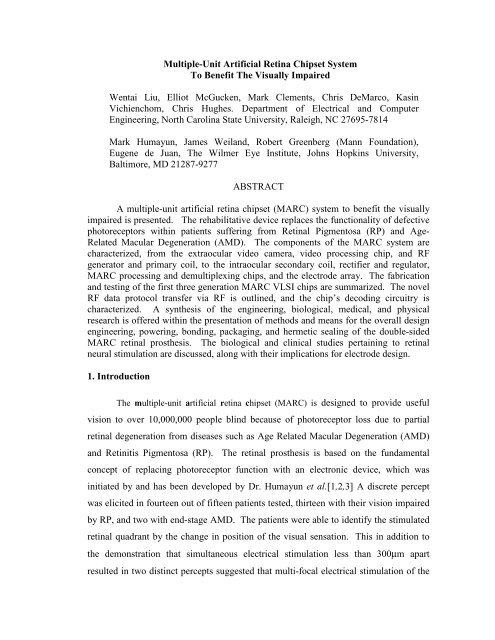
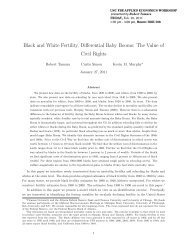

![15. RS 1.003 (RaJsu-yeni - nql?) RS 18.056 (RaJsu-yeni -5'[ ... ])](https://img.yumpu.com/51622603/1/189x260/15-rs-1003-rajsu-yeni-nql-rs-18056-rajsu-yeni-5-.jpg?quality=85)
